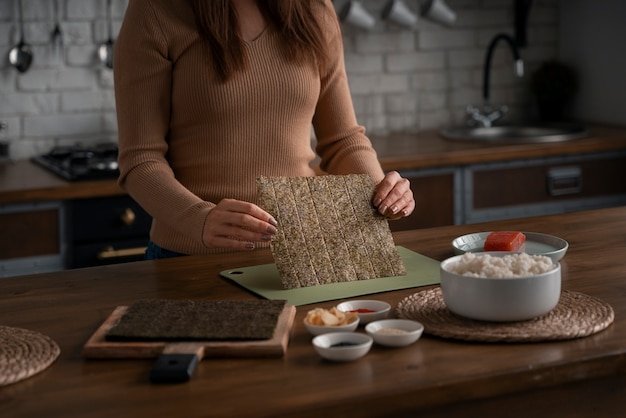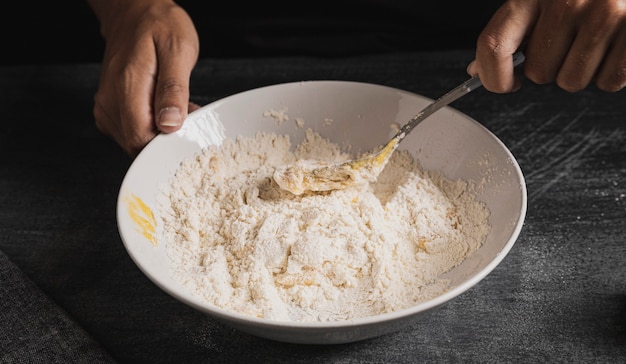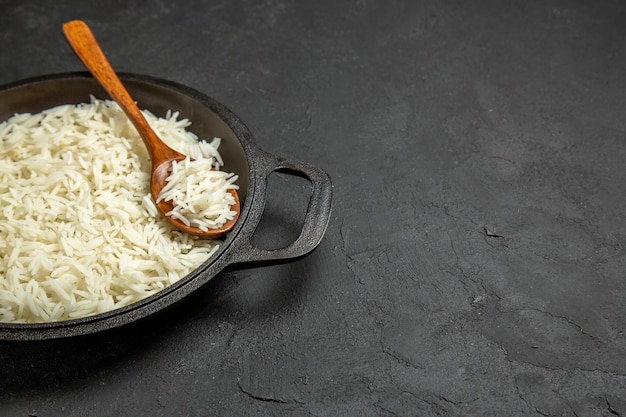Let's be honest, cooking rice can be a bit of a gamble, right? You throw some grains into a pot, add water, and...well, sometimes it comes out perfectly fluffy and delicious, and other times it's a sticky, clumpy mess. It's enough to make you question your cooking abilities! But fear not, my fellow rice enthusiasts, because I'm here to demystify the art of rice cooking and guide you towards achieving perfectly cooked rice, every single time.
Throughout my culinary adventures, I've tried countless methods, from the classic stovetop technique to fancy rice cookers, even experimenting with pressure cookers. I've learned that the secret to perfect rice isn't just about timing; it's a harmonious blend of factors, like the type of rice, the water-to-rice ratio, and the cooking method. So, let's dive into the world of rice cooking together and discover the secrets to creating rice that's consistently delicious, just like your favourite restaurant's!
(Part 1) What's the Deal with Different types of rice?

You know, I used to think all rice was pretty much the same – just white grains, right? But, as I delved deeper into the world of rice, I realised there's a whole spectrum of variety out there. Each type of rice has its own unique characteristics, and knowing these differences can transform your rice cooking from a gamble to a guaranteed success.
1. long grain rice
Long grain rice is probably the most familiar type. It's the classic rice you'll find in most supermarkets. These grains are long and slender, and they cook up fluffy and separate, making them ideal for dishes where you want each grain to stand out, like fried rice or a flavorful pilaf. Imagine each grain perfectly cooked, releasing a delightful aroma and inviting you to savour each bite.
2. medium grain rice
Medium grain rice is a bit shorter and plumper than long grain, and it has a slightly sticky texture when cooked. This makes it perfect for dishes where you want the rice to bind together, like sushi or rice balls. The stickiness adds a wonderful cohesiveness, allowing you to mould and shape the rice for those perfectly formed rice balls or delicate sushi rolls.
3. short grain rice
Short grain rice is the shortest and most plump of the three. It's extremely sticky when cooked, which makes it ideal for dishes like japanese rice dishes and mochi. The stickiness is key for these dishes, creating a cohesive texture for delicious rice bowls or even sweet and chewy mochi treats.
(Part 2) The Right Ratio is Key

One of the most important things to remember when cooking rice is the water-to-rice ratio. This ratio determines the texture of your cooked rice, so it's worth getting it right to avoid a disappointing rice experience.
1. The 1:2 Ratio
For most long grain rice varieties, the standard ratio is 1 cup of rice to 2 cups of water. This ratio will produce fluffy, separate grains, perfect for dishes where you want to appreciate each grain's texture and flavour.
2. Adjusting for Different Types of Rice
For medium grain rice, you'll want to reduce the water a bit, using a 1:1.5 ratio. This will help to prevent the rice from becoming too sticky, allowing you to enjoy its slightly adhesive texture without it becoming too overwhelming. Short grain rice requires even less water, with a 1:1.25 ratio being ideal. This ensures that the rice achieves its characteristic stickiness without becoming overly mushy.
(Part 3) Mastering the Stovetop Method

The stovetop method is the most traditional way to cook rice, and it's surprisingly simple to master once you understand the key elements. Here's my step-by-step guide to perfect stovetop rice:
1. Choose Your Pot
A medium-sized saucepan with a lid is the perfect choice for cooking rice. I like to use a non-stick pot, as it makes for easier cleanup and prevents sticking, ensuring that your rice doesn't stick to the bottom and create a burnt mess.
2. Rinse the Rice
This step is crucial! Rinsing the rice helps to remove excess starch, which can make the rice sticky and mushy. Imagine rinsing the rice under cold water until the water runs clear, gently removing any excess starch that could negatively impact the texture.
3. Combine Rice and Water
Add the rinsed rice to the saucepan and pour in the required amount of water. I always use filtered water for cooking rice, as it gives it a cleaner taste. The water acts as the medium for cooking, and using filtered water ensures that no impurities affect the flavour of your rice.
4. Bring to a Boil
Place the saucepan over medium heat and bring the water to a boil. Make sure you keep an eye on it to prevent it from boiling over. The boiling process releases steam and helps to soften the rice grains.
5. Reduce Heat and Simmer
Once the water boils, reduce the heat to low, cover the pot, and simmer for 15-20 minutes, or until the rice is cooked through. This is where the magic happens, allowing the rice to absorb the water and cook to perfection.
6. Let it Rest
This is a crucial step! Once the rice is cooked, let it rest covered for 10 minutes before fluffing it with a fork. This allows the rice to absorb any remaining water and ensures it's perfectly cooked. The resting period allows the rice to achieve optimal texture and prevent any unwanted sogginess.
(Part 4) The Rice Cooker Advantage
Rice cookers are a game-changer when it comes to cooking rice, and they're definitely worth the investment if you're a frequent rice eater. They're super easy to use and take all the guesswork out of the process, ensuring consistent results every time.
1. Simple Operation
Most rice cookers come with simple instructions, and they usually have pre-set programs for different types of rice. All you need to do is add the rice, water, and press the "cook" button. It's as simple as that! The rice cooker does all the work for you, making rice cooking a stress-free experience.
2. Consistent Results
Rice cookers are designed to cook rice evenly, ensuring that each grain is perfectly cooked and fluffy. You won't have to worry about overcooked or undercooked rice anymore! The rice cooker's precise temperature control ensures that every grain reaches the optimal cooking point, eliminating any inconsistencies.
3. Other Functions
Many rice cookers also have other functions, such as a "keep warm" setting to keep your rice warm for hours, and some even have a "slow cooker" function for making rice dishes. Imagine having perfectly cooked rice readily available for your meals, or even preparing slow-cooked rice dishes with ease.
(Part 5) The Power of Pressure Cooking
If you're looking for the fastest way to cook rice, then a pressure cooker is the way to go. This method uses steam pressure to cook rice quickly and efficiently, making it perfect for those busy evenings when time is of the essence.
1. Quick cooking time
Pressure cookers can cook rice in about 5-10 minutes, compared to the 15-20 minutes needed for the stovetop method. Imagine a delicious bowl of rice ready in a fraction of the time!
2. Less Water Needed
You'll need less water to cook rice in a pressure cooker, as the steam pressure helps to cook the rice more thoroughly. The pressure cooker's sealed environment traps steam and cooks the rice faster and more efficiently.
3. Important Notes
It's essential to follow the manufacturer's instructions carefully when using a pressure cooker, as improper use can be dangerous. Also, make sure to release the pressure slowly to prevent splattering hot water. Safety first, always!
(Part 6) Experimenting with Different Methods
Once you've mastered the basics of rice cooking, you can start to experiment with different methods and techniques to create diverse and flavourful rice dishes.
1. Trying Different Rice Varieties
There are countless types of rice available, from brown rice to black rice to wild rice. Each type has its own unique flavour and texture, so it's worth trying different varieties to find your favourites. Imagine the world of culinary possibilities opening up as you explore different rice varieties, each offering a unique flavour and texture.
2. Adding Flavour
Rice can be a blank canvas for flavour, and you can add different spices, herbs, and aromatics to your cooking water. For example, adding a bay leaf and a few peppercorns can give your rice a subtle earthy flavour. Imagine the rice absorbing the aromas of your favourite spices, creating a dish that tantalises your taste buds.
3. Trying Different Toppings
You can also add different toppings to your rice, such as chopped nuts, seeds, or fresh herbs. This can add a bit of crunch and flavour to your dish. Picture a fluffy bowl of rice topped with crunchy nuts, aromatic herbs, or a sprinkle of sesame seeds, adding depth and complexity to the flavour.
(Part 7) Common Rice cooking mistakes
Everyone makes mistakes in the kitchen, and rice cooking is no exception. Here are some common mistakes to avoid, ensuring that you achieve perfect rice every time:
1. Not Rinsing the Rice
Rinsing your rice is essential for removing excess starch, so don't skip this step. Imagine the rice grains glistening after a thorough rinse, free from excess starch that could make it sticky and mushy.
2. Not Using Enough Water
Underestimating the water ratio can lead to dry, crunchy rice. Make sure to use the right amount of water for your chosen type of rice. Visualise a perfectly cooked rice grain, soft and fluffy, which is only achievable with the correct water-to-rice ratio.
3. Overcooking the Rice
Overcooked rice can become mushy and sticky. Follow the recommended cooking times closely. Remember that the cooking time varies depending on the type of rice and cooking method, so it's essential to follow the instructions carefully.
4. Not Letting the Rice Rest
Allowing the rice to rest after cooking is crucial for absorbing the remaining water and ensuring fluffy grains. Picture the rice grains plumping up beautifully as they rest, absorbing any remaining moisture and achieving the perfect texture.
(Part 8) FAQs
1. Can I Cook Rice in the Microwave?
You can cook rice in the microwave, but it's not always the best method, as it can lead to uneven cooking. If you're short on time, you can try it, but the results won't be as consistent as the stovetop or rice cooker methods.
2. How Can I Prevent Rice from Sticking to the Pot?
Rinsing the rice is the best way to prevent sticking. You can also add a tablespoon of oil or butter to the water before bringing it to a boil. Imagine the rice gliding effortlessly in the pot, thanks to the addition of oil or butter, preventing it from sticking and creating a delicious and hassle-free cooking experience.
3. Can I Freeze Cooked Rice?
Yes, you can freeze cooked rice for up to 3 months. However, it's important to freeze the rice in a single layer to prevent clumping. Picture a perfectly frozen bowl of rice, ready to be thawed and enjoyed in delicious dishes.
4. What's the Best Way to Reheat Rice?
Reheating rice in the microwave or on the stovetop is fine, but make sure it's heated through to prevent food poisoning. Visualize reheating the rice until it's steaming hot, ensuring that it's safe and delicious to eat.
5. How Can I Tell if Rice is Cooked?
You can tell if rice is cooked by checking the texture. It should be tender and fluffy, and the grains should be separate. You can also check for a small indentation when you press on a grain with your finger. Imagine pressing on a cooked rice grain and feeling a slight give, a sign that it's perfectly cooked and ready to enjoy.
(Part 9) My Favourite rice recipes
Now that you've mastered the art of cooking rice, it's time to try some delicious recipes! Here are a few of my personal favourites, showcasing the versatility of rice in creating diverse and flavourful dishes.
1. Chicken and Rice Soup
This classic soup is comforting and easy to make. Simply cook some chicken and rice in a pot with broth, vegetables, and your favourite seasonings. Imagine a warm and satisfying bowl of chicken and rice soup, perfect for a cozy evening.
2. Fried Rice
Fried rice is a delicious and versatile dish that can be made with any leftover rice. Simply stir-fry the rice with your favourite vegetables, meats, and seasonings. Picture a flavorful stir-fry of rice with crunchy vegetables and aromatic meats, a perfect way to use leftover rice.
3. Sushi Rolls
Sushi rolls are a fun and creative way to use rice. There are endless possibilities for fillings, so you can make sushi rolls to suit your taste. Visualize a beautiful sushi roll, filled with fresh ingredients and perfectly shaped rice, ready to be enjoyed with soy sauce and wasabi.
4. rice pudding
Rice pudding is a classic dessert that's creamy, comforting, and delicious. Simply cook rice with milk, sugar, and your favourite spices. Imagine a warm and comforting bowl of rice pudding, spiced with cinnamon and nutmeg, a perfect end to a delicious meal.
(Part 10) Embracing the Joy of Cooking Rice
Cooking rice might seem simple, but it's a fundamental skill in the kitchen that can unlock a world of culinary possibilities. Remember, practice makes perfect, so don't be afraid to experiment and find what works best for you. From fluffy long grain rice for a simple side dish to sticky short grain rice for a delicious sushi bowl, the world of rice is yours to explore. So, go on, grab your favourite rice and start cooking! The possibilities are endless, and with a little practice, you'll be a rice-cooking master in no time.
Everyone is watching

How to Cook Frozen Lobster Tails Perfectly: A Step-by-Step Guide
RecipesLobster. Just the word conjures up images of lavish meals, special occasions, and a taste of luxury. But let's...

Pigs in a Blanket Cooking Time: How Long to Bake for Perfect Results
RecipesAh, pigs in a blanket. Just the name conjures up images of those delightful little parcels of crispy pastry en...

Pork Fillet Cooking Time: How Long to Cook It Perfectly
RecipesPork fillet, or tenderloin as it's sometimes called, is a real favourite in our house. It's so versatile, and...

The Ultimate Guide to Tender, Juicy Pulled Pork
RecipesRight, let's talk pulled pork. It's one of those dishes that just screams "comfort food," doesn't it? I mean...

The Ultimate Guide to Cooking Sweet Potatoes: From Roasting to Mashing
RecipesSweet potatoes. Just the name conjures up images of warm, comforting dishes, bursts of vibrant color, and a to...
